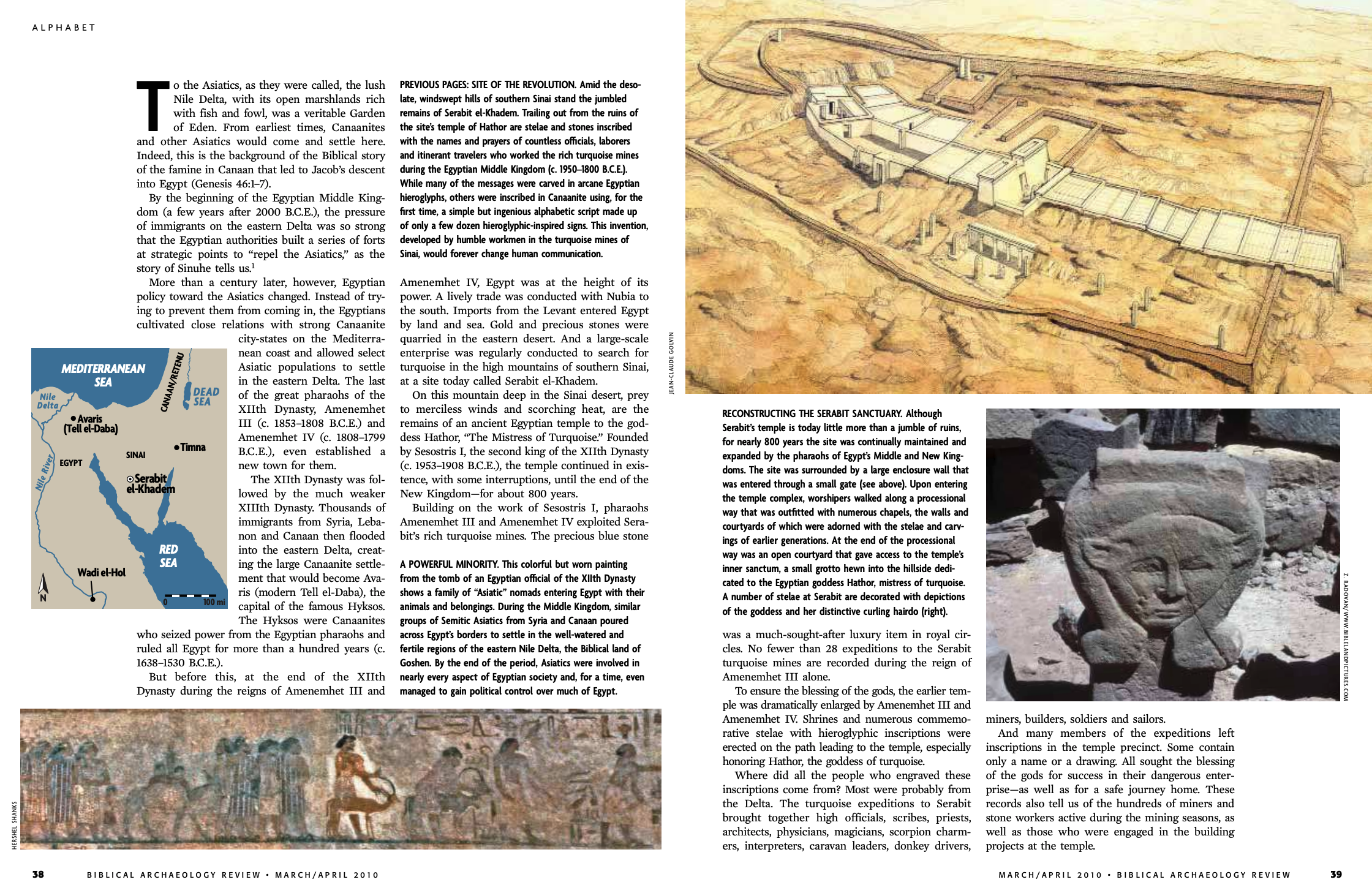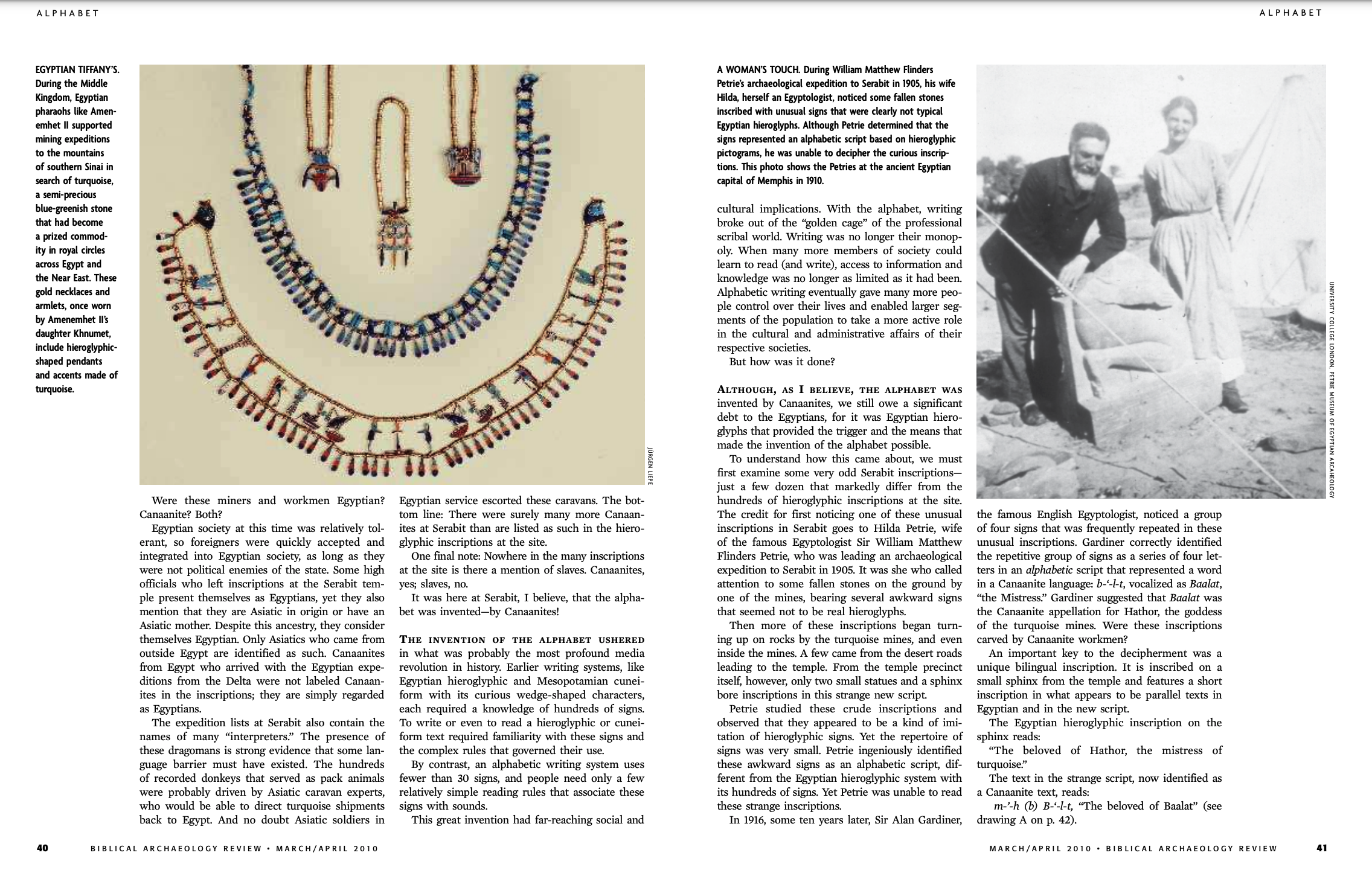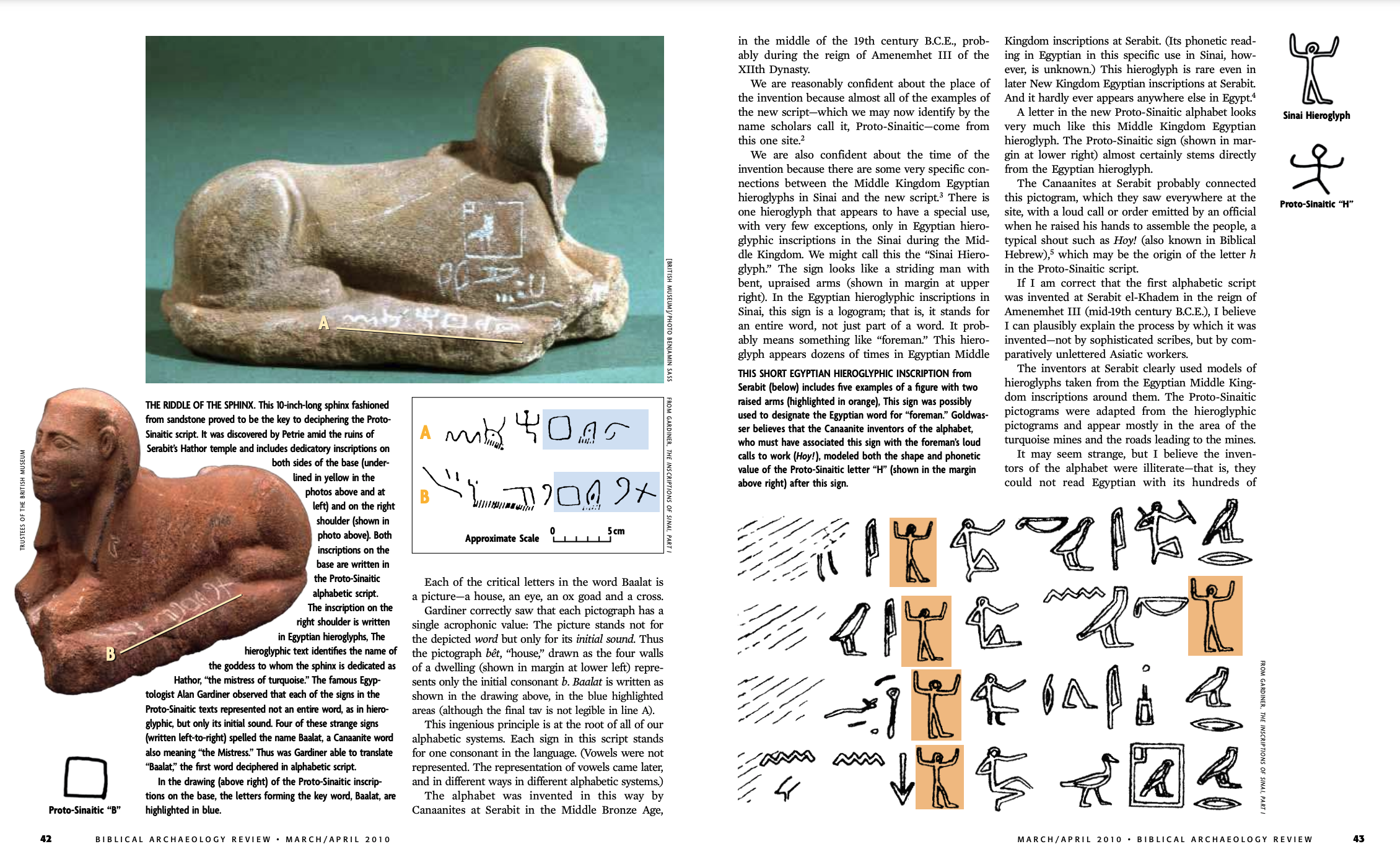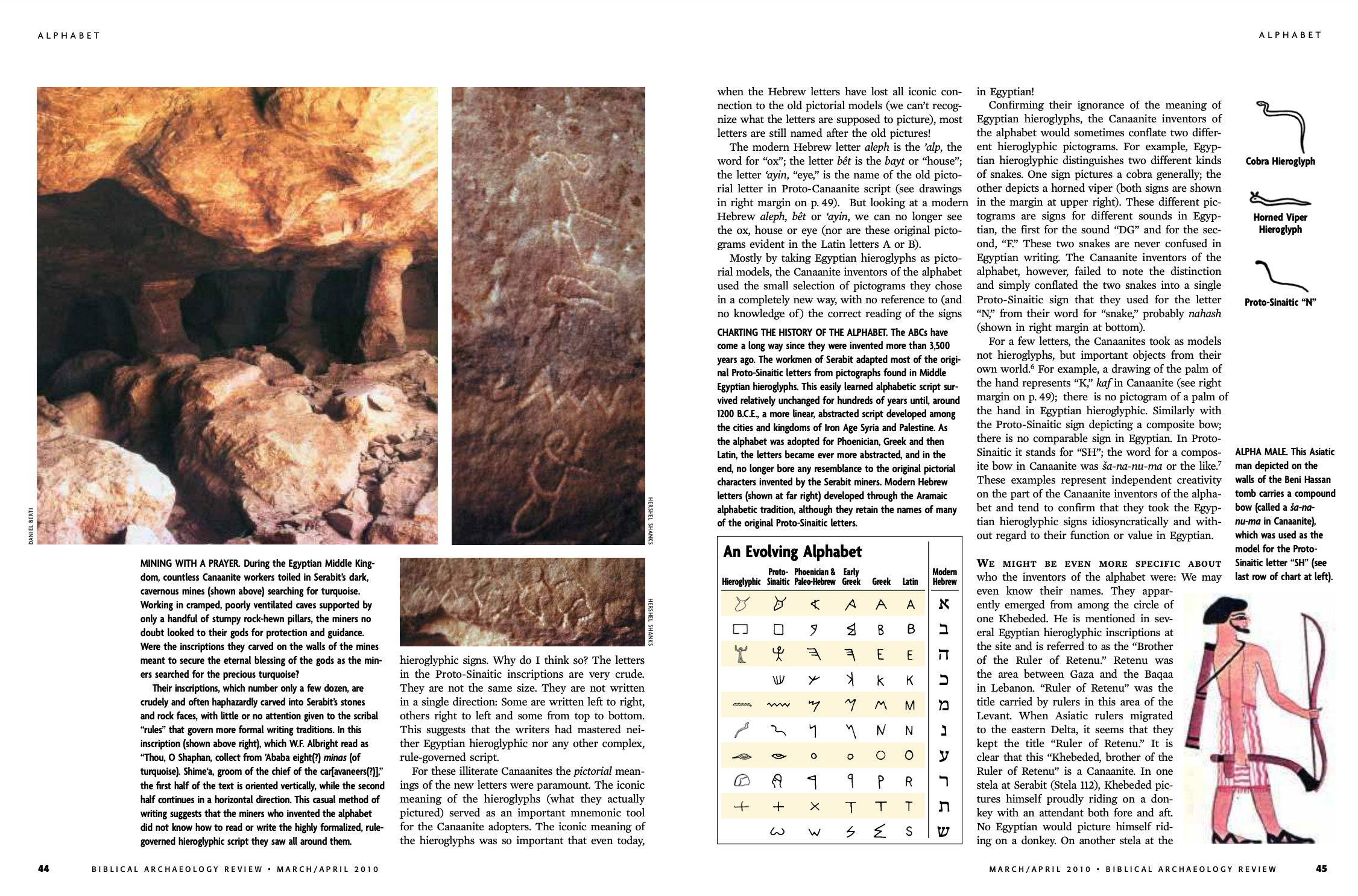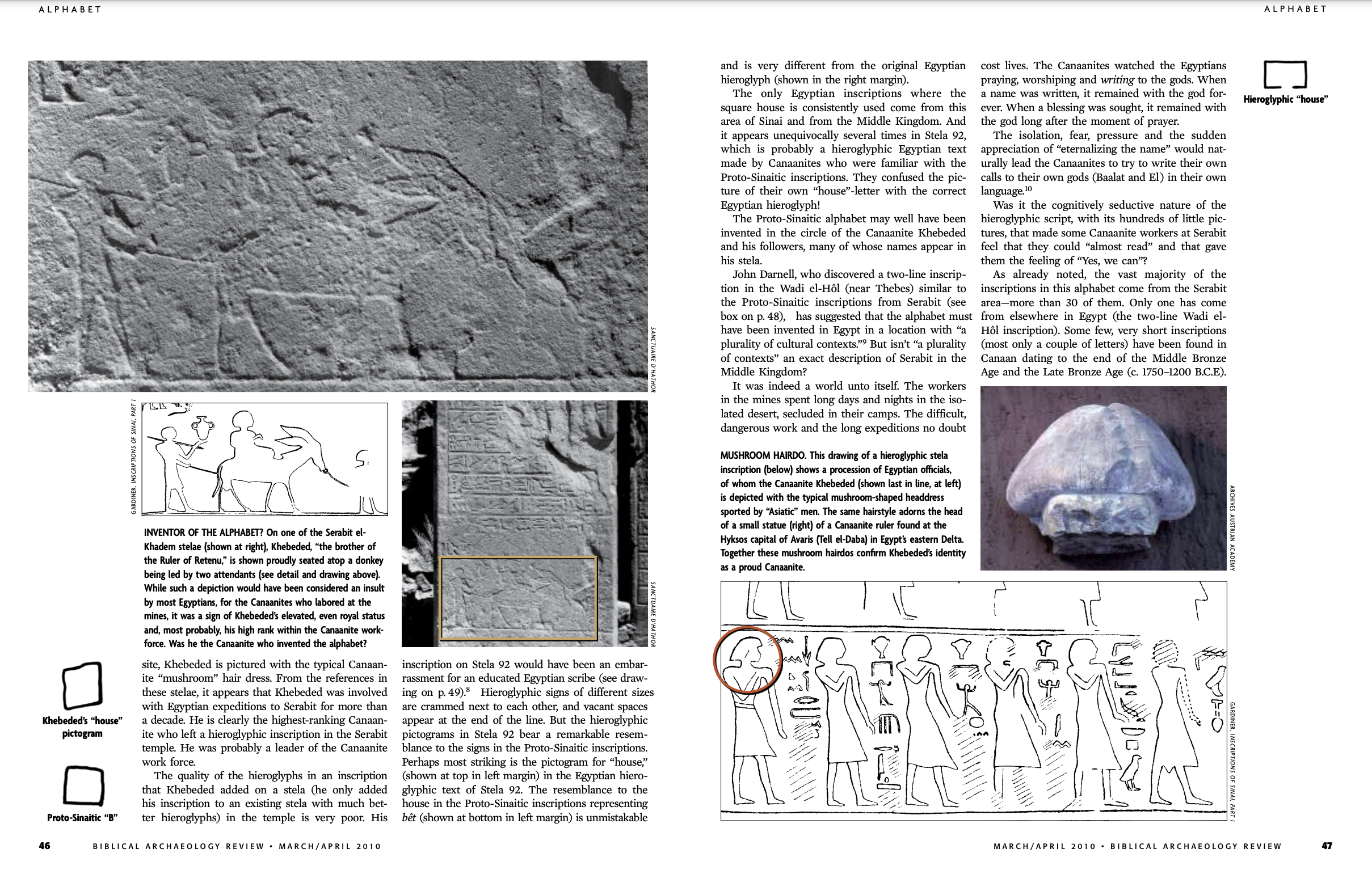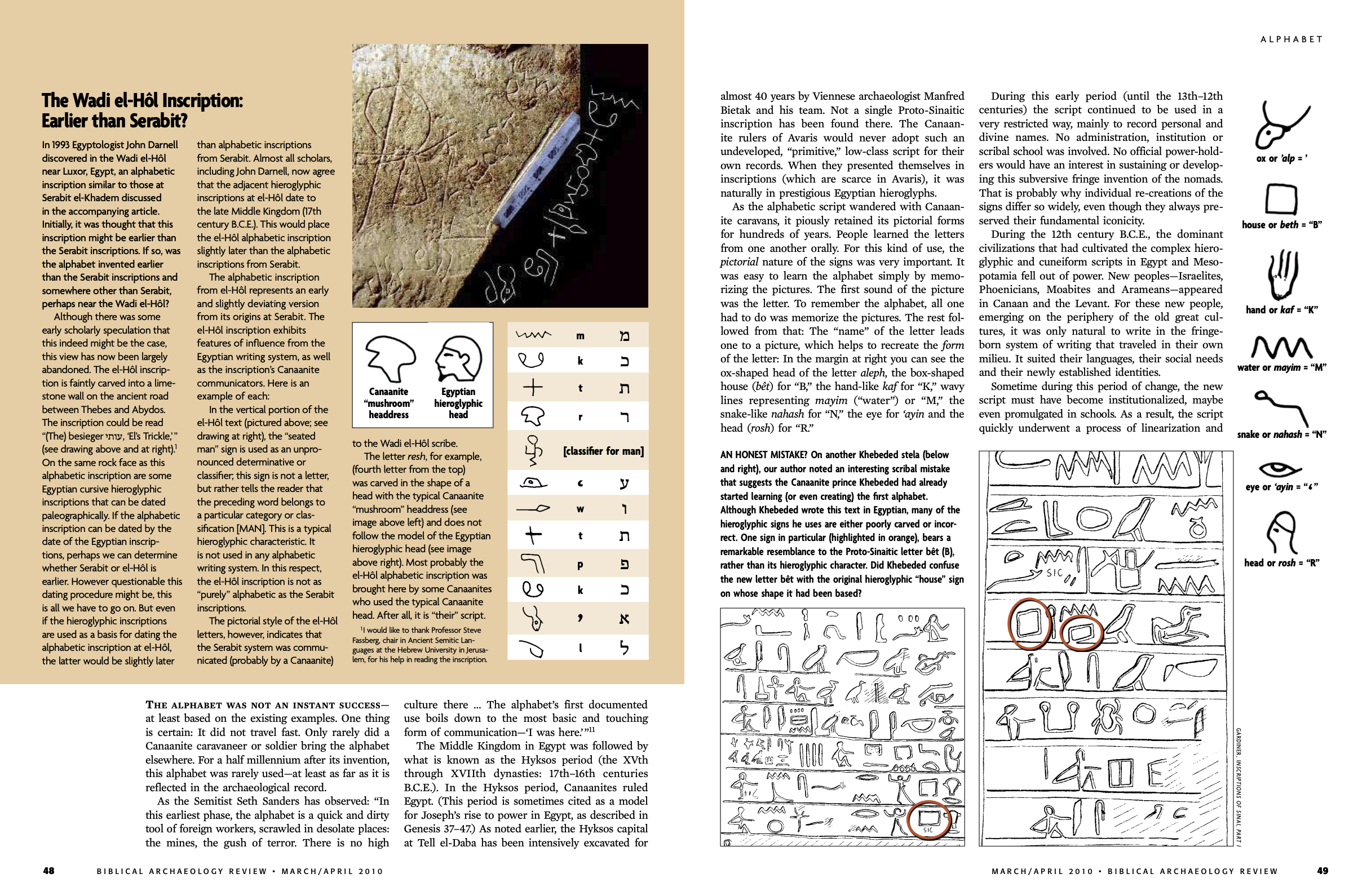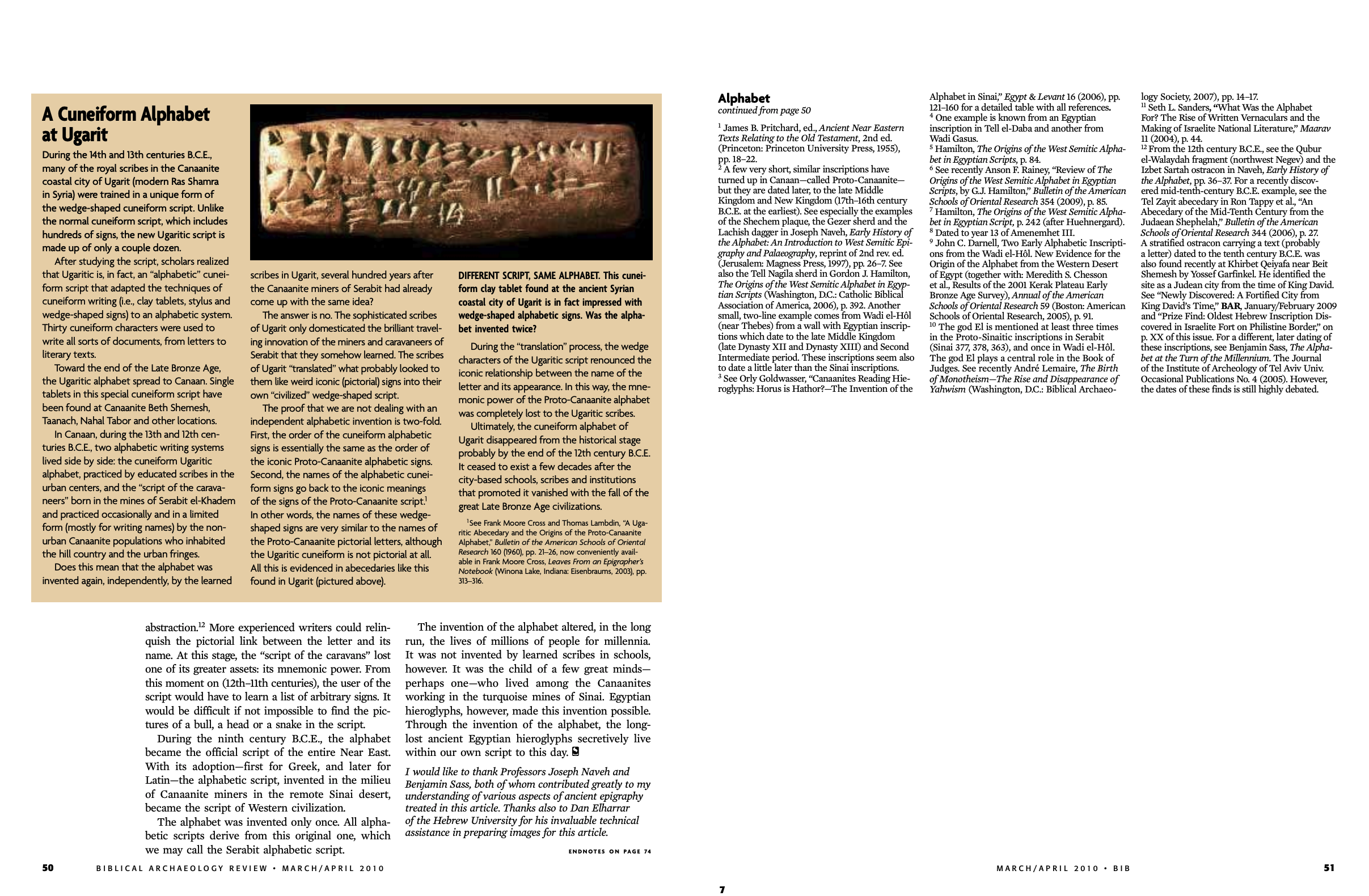Egyptian Origin of Our Alphabet
Revealing a single evolution of the alphabet!
There have been other writing systems, but not other alphabets.
The long-lost Ancient Egyptian hieroglyphs secretly live within our own script to this day, through the invention of the alphabet.
It was not invented by a highly trained scribe, but a Canaanite worker in the turquoise mines of Sinai. It was a fringe script of the workers that took 500 years to catch on to the wider world.
Individual re-creations of the signs differ widely, but always preserve their fundamental iconography of the parent [Egyptian] script.
During the 1100’s BC, the dominant civilizations fell out of power - these were the ones that created the complex hieroglyphic and cuneiform scripts in Egypt and Mesopotamia. New people appeared in Canaan and the Levant [Judea], on the periphery of the old great cultures.
The simple alphabetic structure took on the first consonant sound of the Egyptian hieroglyphic, and reduced hundreds of symbols to about 30. This simple script fit the needs of masses of people, and was easily learned. At some point it spread and had its own rules for grammar, some variations becomeing more slanty than symbolic, but all from the same base of the Egyptian hieroglyphics. And, sadly, they all lost their pneumatic power that linked them to their original language. Most of the original connections have been lost, but a few have been deciphered!
Listen to the Podcast for a summary of the research:
Quick Timeline
Modeled after the much more complex Ancient Egyptian hieroglyphs, Cananites (from Judea, writing in Egypt) created a simplified “Proto-Sinaitic” Alphabet
Summary: After Egyptians created their writing system, 1,500 years would pass before a simple script developed in 1900 BC by canaanites, then made its way to Greeks by 1200-900 BC
Egyptian Hieroglyphs 3200 BC ->
Proto-Sinaitic/Old Canaanite 1900 BC ->
Developed by the Phoenicians (just north of Judea)
Phoenician -> Aramaic -> Hebrew
Phoenician -> Syriac -> Arabic
Phoenician -> Greek -> Latin
Passed to the Greeks between 1200 and 900 BC.
Some examples
A > alp (ox in ancient Egyptian) > aleph (Hebrew ) > alpha (Greek)
B > bayt (house in Egyptian) > beta (Greek)
H > Hoy! (the sound made by “foreman”, also in biblical Hebrew)
symbol of a man with arms raised (below)
M > maa (a squiggle on its side meant to symbolize water flowing)
N > nahash (snake)
and a great example of the slight variation in Egyptian text, they had two versions of snakes, one cobra, and another viper, used interchangeably in the new script
Oldest Languages in the World
Some of the oldest ancient languages started out as complicated pictoral systems (as opposed to a simple phonetic structure of letters). Some locations that created their own language independently include:
3,500 BC: India, fragments of pottery at Harappa in Pakistan
3,400 BC: Mesopotamia, Sumer in Iraq
3,400 BC: Ancient Egyptian Hieroglyphs
1,400 BC: Chinese, found on ox bones, tortoiseshells, and bronze
*Dates chosen here are OLDEST dates listed, which only get older as more evidence is uncovered, especially as technology develops allowing us to reach in places under water!
Finding the inscriptions
In 1905, Egyptologist Hilda Petrie was on an exhibition led by her famous archeologist husband, when she noticed unusual unscriptions in Serabit near one of the mines that did not seem to be real hieroglyphs. More insciptions turned up- all with spelling errors, grammar errors, text written left to right, right to left, and up and down- all novice mistakes that would never be seen in official script. Once in the land closer to the temple, only two small statues and a sphinx bore inscriptions of the new script, meaning most of the writings near the holy place were more official. Hilda ingenioulsy identified the imitation hieroglyphic signs as alphabetic, different from the much larger base of Egyptian script. But none of the inscriptions could yet be deciphered.
1916, ten years later, Sir Alan Gardiner noticed a set of four signs that were frequently repeated of these unusual inscriptions, and identified them as a series of letters into the Canaanite langauge: “b-’-l-t”, or baalat, “the Mistress”. Gardiner suggested this was the term for the goddess Hathor, worshipped near the turquoise mines.
One of the small sphinxes featured a parallel text in both Egyptian and the new script. Gardiner correctly saw each pictograph stood for a sound, not a whole word, representing just the initial consonant of the original Egyptian word. This principle is the root of all our alphabetic systems.
A Quick Timeline of Egypt
The lush Nile Delta was a true Garden of Eden, rich with fish, every kind of bird you can imagine, and an ease and simplicity of raising children. People lived in and out of the marshland along the Nile. Each day, waves would pour fish right onto the shore, which could easily be cooked on a rock in the sun. The fish were ground into a flour for storage, and tons of plant life gave them a longevity never seen before or since. This ease of life lead to thousands of years of prosperity, creating a legacy that has been kept alive in modern customs in subtle ways- like the modern alphabet, the way we celebrate birthdays with a cake and candle, all the way down to our most important holiday traditions. The papyrus paper of the Nile was called byblos: treasured by Europe into the Middle Ages, and the root to our word bible.
Ancient Her-story
10,000 BC: Egyptian desert climate changes: more rainfall, lakes, attracting early humans
Analyses of skulls reveal people who will later become the ancient Egyptians were phenotypically identical to Black Africans
7,500 BC: Earliest evidence of Egyptians from the Nabta Playa (500 miles south of Cairo)
earliest royal tombs and the first calendar were found much further south of the Delta. Deep wells held water year round. Staying in one place lead to perceptions in astronomical patterns.
6,400 BC: Radiocarbon dating of campfires in the area
supports the idea of a civilization starting to understand the stars
5,500 BC: Evidence of a religion starting to form
Evidence of goddess Hathor, protector in the night, of love, childbirth, ox
4,800 BC: Star Maps/calendar, stones lining up to stars and summer solstice sunrise
Built around the same time as the Goseck circle in Germany and the Mnajdra megalithic temple complex in Malta
First Hieroglyphics
3,400 BC: Hieroglyphics found on ivory and clay pottery in Abydos (300 miles south of Cairo)
3,000 BC: The first Brewery in the religious city of Abydos, south along the Nile
2,000 BC: Egyptian Kingdoms see pressure from immigrants
a series of forts were built to “repel the Asiatics” - Sinuhe (Egyptian literature)
Canaanite spells have been discovered in 2002 on Egyptian tombs, dating to the 3rd millenium BC.
1,900 BC: Egypt at the height of its power, friendlier with trade
Exchange of goods with Nubia (south) and Canaan (Judea) by land and sea
Gold and precious stones quarried from the desert
Large-scale expeditions (28 under one pharaoh alone) for turquoise in mountains of Serabit, on the Sinai peninsula. Here we find ancient Egyptian temples to the Goddess Hathor, “Mistress of Turquoise" (founded by 1,908 BC, temple surviving for 800 years).
Start of alphabetic script appearing along the route to the turquoise mines
1,850 BC: The last of the Great Pharaohs builds a new town for foreigners
1,800 BC: The Egyptian dynasty is a much weaker than the previous ones (13th Dynasty)
thousands of immigrants from Syria, Labanon and Canaan flood in and create a settlement that becomes known as Avaris, capital of the Hyksos
The Story of Sinuhe, ancient Egyptian literature, about an Egyptian who flees his kingdom, lives as a foreigner, and returns home shortly before his death. The work was so popular, newer copies were still made 750 years later.
1,638-1,530 BC: Canaanite kings in power over Egypt over 100 years (Hyksos)
The Hyksos did not control all of Egypt, co-existing with Pharoahs in Thebes
1,530 BC: Native Egyptians back in power
1,200 BC: After about 700 years of the alphabet invented in the mines, linear script appears
Script remaining relatively unchanged and isolated to Egypt, until seen in Judea in a more linear style, then adopted in Phoenecian, Greek, then Latin, becoming more abstract. You can see the Hebrew letters are much closer to the original Egyptian than later Latin.
In the 1200’s BC, Egypt and Mesopotamia both start to lose power (signifying a greater problem, something like a larger climate event), and new people started to emerge on the periphery of the old great cultures. During this period of change, the new script grew its own set of rules, and the original pictographs eventually forgotten. This “script of the caravans” lost one of its greatest assets": its mnemonic power (sounding like what it stands for). To learn the script from this point on, a person would have to memorize a list of arbitrary signs.
By the 800’s BC: the alphabet became the official script of the Near East, adoption in Greek, Latin, then the rest of the Western civilization.
700’s BC on: Egyptians loss of power to Persians, then Greeks, then Romans, then Turks
2020 AD: Coptic script, a form of Ancient Egyptian, still used in Egyptian Christian churches
The Development of the Alphabet
It is along the long route from the Delta in Egypt to the Turquoise quarries in the mountains of the Sinai peninsula that we see “unofficial” shrines and monuments with various inscriptions- hieroglyph and other text- especially honoring Hathor, appear around 1900 BC.
The exhibitions for mining turquoise would have included scribes, priests, architects, doctors, magicans, hundreds of donkey drivers, soldiers, and workers of all kinds. In the enscriptions, Canaanites are simply regarded as Egyptian, not specified as an outsider.
Expedition lists also include interpreters, meaning various languages were used. And there was no mention of slaves. Diodorus, however, writing in 60 BC from earlier sources, does mention some working of the mines, and how difficult it could be.
This is where it is supposed that the alphabet was written- by Canaanites, along Egypt turquoise routes. Earlier forms of writing systems require life long studies of hundreds of signs and complex rules. In contrast, an alphabet requires only to remember 30 signs and associating them with sounds.
Social implications of this simpler script mean that writing was able to break out of its “golden cage” of the professional scribe world. Writing was no longer their monomoly. Access to information was more open, and people could take a more active role in administration.
Even if the alphabet was invented by Canaanites, we still owe a significant debt to the Egyptians. It was their hieroglyphics that provided the trigger for the roots words of the larger language. Plus their tolerance of outsiders and flow of exchange of information in the mines and the economy around them allowed an independent culture to develop. The new alphabet needed “plurality of contexts” to develop. Egypt itself had no need to simplify its writing.
The best guess of the creation of the language was during the reign of Amenemhet III around 1850 BC in Serabit of Egypt. We are reasonably confident about the place and time of invention because almost all examples of the new script (one other found in Wadi El-Hol Egypt), were found in this one site.
But even more recently, a Canaanite spell was found in a pyramid Saqqara, pushing the oldest known used of the pre-Hebrew/Phoenician script even further back, to 2,500 to 3,000 BC. “The texts will also be important to biblical scholars, since they shed light on several rare words in the Bible,” said the professor. While the Egyptians took a disparaging view of their neighbors’ culture, their fear of snakes and desire to protect royal mummies against them may have made them open to the borrowing of Semitic magic.
In the new script, each sign stands for one consonant, and vowels were not represented, just as they were not included in Hebrew of the bible, often leading to difficulty in translations! Vowels came later, and in different ways in different alphabetic systems.
Even as Hebrew letters lost their iconic connection to Egyptian’s pictoral models (we can no longer recognize what the letters are supposed to picture), most letters are still named after the old pictures!
Basically, the Canaanite inventors of the alphabet used the images of the hieroglyphs around them, with no understanding of how to actually read them, in a completely new way. In the world of the mines, workers would have spent a lot of time mixed in with the Egyptians, watching them pray and write to the gods. When a name was written, it remained with the god forever. When a blessing was spoken, it remained long after the moment of the prayer.
We may even know the name of a potential inventor of this alphabet, one who inscribed in Egyptian Hieroglyphics as “Khebedeb, brother of the Ruler of the Retenu”, land between Judea and Lebanon. He was drawn riding a donkey, something an Egyptian would never picture for themself.
30 of the inscriptions of this alphabet come from the Serabit mines in the Sinai peninsula of Egypt. Only one unique one developed in the Wadi el-Hol inscription along the Nile.
For 500 years after its invention, this alphabet was rarely used - at least in the archaeological record. It was scrawled in desolate places near the mines. As the alphabetic script wandered with the Canaanite caravans, it retained its pictoral form for hundreds of years. People learned the letters orally from one another. It was easy to learn by memorizing the pictures. The first sound of the picture was the letter. To remember the alphabet, all one had to do was memorize the pictures.
In the 1200’s BC, Egypt and Mesopotamia both start to lose power (signifying a greater problem, something like a larger climate event), and new people started to emerge on the periphery of the old great cultures. During this period of change, the new script grew its own set of rules, and the original pictographs eventually forgotten. This “script of the caravans” lost one of its greatest assets": its mnemonic power (sounding like what it stands for). To learn the script from this point on, a person would have to memorize a list of arbitrary signs.
By the 800’s BC: the alphabet became the oifficial script of the near east, adoption in Greek, Latin, then the rest of the Western civilization.
This alphabet was invented only once. All alphabetic scripts derive from this original one, used in the obscure mines in the desert and mountains of Egypt. We may call it the Serabit alphabetic script, or the Khebedeb script, or the Hathor script. Scientists confusingly call it the Proto-Sinaitic-something script.
Through the invention of the alphabet, the long-lost ancient Egyptian hieroglyphs secretively live within our own script to this day.
Resources
2010 Biblical Archaeology Review article, “How the Alphabet Was Born from Hieroglyphs.” Goldwasser PDF, Goldwasser, Orly (Mar–Apr 2010). Biblical Archaeology Review. Washington, DC: Biblical Archaeology Society. 36 (1). ISSN 0098-9444. Retrieved 6 Nov 2011.
"Oldest alphabet found in Egypt". BBC. 15 November 1999.
^ WILFORD, John Noble (13 November 1999). "Discovery of Egyptian Inscriptions Indicates an Earlier Date for Origin of the Alphabet". The New York Times.
Deciphering the Script, LeBlanc, P.D. (2017). Deciphering the Proto-Sinaitic Script: Making Sense of the Wadi el-Hol and Serabit el-Khadim Early Alphabetic Inscriptions. Unknown Publisher. ISBN 978-0-9952844-0-1. Retrieved 2023-04-30. 11
Baker, Dorie (13 December 1999). "Finding sheds new light on the alphabet's origins". Yale Bulletin and Calendar.
YUNews, Steiner, Semetic Serpent Spells in Egypt Dechipered, 2007
The discovery of the most recent 2002 find made news around the world, appearing in USA Today, the International Herald Tribune, National Geographic, Haaretz, Jerusalem Post, and MSNBC.com













